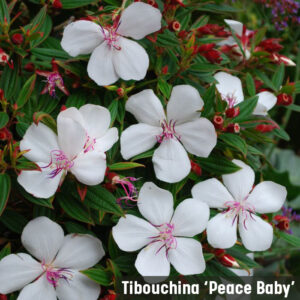Tibouchina
Tibouchinas are seen at their purple best in autumn when most are in full flower. These evergreen shrubs or small trees thrive in warm, sheltered gardens that are protected from frost. These are adaptable plants that can grow in full sun or part shade.
Tibouchinas (also known as lasiandra or glory bush) originated in parts of tropical South America including Brazil but are widely grown in Australia. The town of Alstonville in northern New South Wales has tibouchinas as a feature plant in the town with shrubs and trees growing as street plantings and in local parks and gardens.
As well has having attractive flowers over many weeks in autumn (with some also blooming in spring), tibouchinas have attractive dark green leaves with distinct veining and stems and buds that can be flushed with purple tones.
 Tree or shrub?
Tree or shrub?
The commonly grown tibouchina species include Tibouchina granulosa, which can form a 10-metre-high tree, T. macrantha, which grows to around 3 metres high and wide, and T. urvilleana, which grows as a shrub to 4.5 metres high. These plants are often seen as mature specimens in old gardens. Today tibouchinas are more likely to be sold as named varieties with many bred as compact garden plants.
As there is a range of sizes among tibouchinas, there’s a plant for just about any sized garden or situation. In large gardens, plant a tall-growing tibouchina trained to form a small tree or use it as an autumn feature in a shrub border. To accentuate the tree-like shape of a tall tibouchina, prune away lower branches to create a single stem. A good choice for a tall-growing variety is ‘Alstonville’ (T. lepidota), pictured above, which grows to around 5 metres. For a more medium-sized shrub, try 'Carol Lyn', which will grow to 1.5m in height and around 1m in width.
For small growers select ‘Jules’, which forms a low plant around 60 centimetres high and wide, or ‘Jazzie’, which has large purple flowers on a 1-metre-high bush. ‘Groovy Baby’ is another compact grower reaching just 45 centimetres high and wide. This variety originated in Queensland and is now widely grown in Australian gardens. It flowers from spring to autumn. All these compact varieties can be grown in containers, raised beds or as a low hedge or border.
 Other colours
Other colours
Although the purple-flowered species and varieties are the best known among the tibouchinas, there are other flower colours available. ‘Kathleen’ has pink flowers and blooms from spring to autumn. It grows as a tall shrub or small tree to around 5 metres high.
For striking white blooms seek out ‘Peace Baby’, which has prominent pink stamens in the centre of its white petals. For a mix of pink and white flowers choose ‘Cool Baby’, another selection from Queensland. Growing to a compact 45cm high and wide and smothered in blooms for many months, this plant can be grown in a shrub border, as a low hedge or feature plant in a large container. 'Foxxy Baby' also features bicoloured pink and white blossoms with eye-catching purple stamens on a petite shrub growing up to 1m. 'Blue Moon' features gorgeous lilac-blue blossoms on a shrub up to 1.5m high and wide, while 'Chameleon' grows up to 2m and puts on a show of colour-changing blossoms, which start out white and deepen to an array of pink and purple hues as they age.
 Care tips
Care tips
Tibouchinas grow quickly and have few pest or disease problems. Flowering will be reduced if plants are too heavily shaded. Growth may also become leggy and unattractive in heavy shade.
To maintain a dense shape, lightly prune tibouchinas after flowering or in early spring. Rejuvenate old, woody plants by giving them a hard prune in early spring to encourage new growth. Very woody plants should be pruned progressively over a period of several weeks waiting for new growth to appear before cutting more branches. Where surrounding growth overshadows old plants assess whether surrounding plants also need to be pruned to allow extra light into this part of the garden. Want pruning tips? Read our ultimate guide here.
Water and feed pruned plants to support the new growth. Once a year fertilise in spring applying a complete fertiliser as temperatures warm. Water regularly especially if summers and early autumn are dry.


